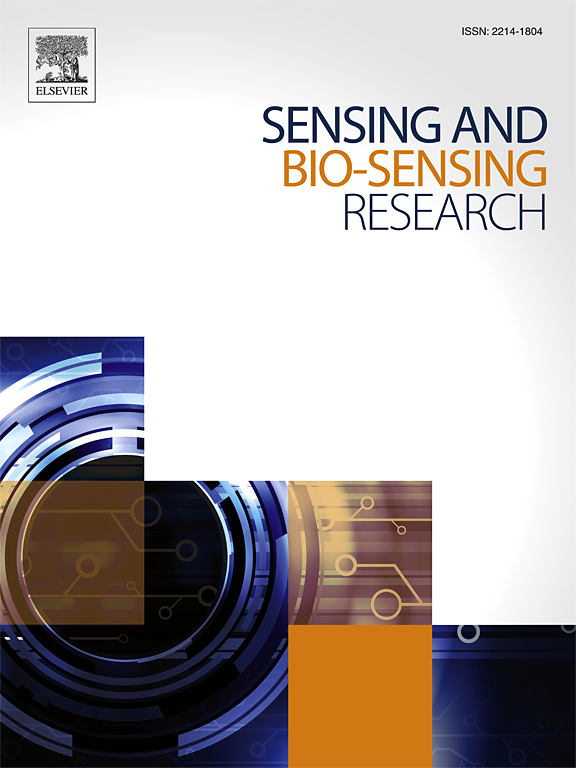一种绿色合成纳米金修饰的丝网印刷碳电极用于饮用水样品中亚硝酸盐的选择性检测
IF 4.9
Q1 CHEMISTRY, ANALYTICAL
引用次数: 0
摘要
纳米材料被广泛应用于医药、环境修复、食品包装和生物医学等领域。与传统的化学合成方法相比,采用环保技术合成纳米颗粒具有令人着迷的特性。在这项工作中,我们展示了一种生态友好的合成金纳米颗粒(AuNPs)的方法,使用相思叶提取物。将AuNPs修饰的丝网印刷电极用于亚硝酸盐的电化学检测。通过FT-IR、XRD、FE-SEM、TEM、EDX和uv -可见分析等技术对合成的AuNPs进行了表征。AuNPs的FT-IR结果显示了参与AuNPs形成的不同官能团。FE-SEM证实了纳米颗粒对团聚的影响,得到了均匀球形的微小纳米颗粒。TEM分析显示AuNPs具有10 ~ 20 nm的小球形纳米颗粒,EDX结果显示Au元素的存在。由于表面等离子体共振,紫外可见吸收带出现在584 nm处,证实了Au离子还原为元素aunp。在优化条件下,修饰AuNPs/SPCE电极对亚硝酸盐离子的电化学检测线性响应范围为0.1 ~ 1000 μM,检出限较低(0.03 μM)。此外,该传感器还具有出色的可重复性、选择性、再现性和存储稳定性。因此,制备的AuNPs/SPCE电极具有多种实际应用,可用于检测水生介质中的亚硝酸盐。本文章由计算机程序翻译,如有差异,请以英文原文为准。
A screen-printed carbon electrode modified with a green synthesized gold nanoparticle for selective detection of nitrite in drinking water sample
Nanomaterials are used in numerous applications such as medicine, environmental remediation, food packaging, and biomedical applications. Nanoparticle synthesis using the eco-friendly technique shows a fascinating property compared to conventional chemical route methods. In this work, we demonstrate an eco-friendly synthesis of gold nanoparticles (AuNPs) using the Acacia nilotica leaf extract. AuNPs modified screen-printed electrode was applied for electrochemical detection of nitrite. Synthesized AuNPs were characterized by various techniques, including FT-IR, XRD, FE-SEM, TEM, EDX, and UV–visible analysis. FT-IR result of AuNPs demonstrate the distinct functional groups involved in the formation of AuNPs. FE-SEM confirms the AuNPs towards agglomeration and tiny nanoparticles were obtained in uniformly spherical in shape. The TEM analysis revealed AuNPs have small spherical nanoparticles with a size ranging from 10 to 20 nm and EDX result displayed the presence of Au element. The UV–visible absorbance band appeared at 584 nm due to surface plasmon resonance, which confirms the reduction of Au ions to elemental AuNPs. At optimized conditions, a wide linear response range from 0.1 to 1000 μM and a relatively low detection limit (0.03 μM) was observed for electrochemical detection of nitrite ion by modified AuNPs/SPCE electrode. Moreover, the sensor demonstrates outstanding repeatability, selectivity, reproducibility, and storage stability. Thus, the fabricated, AuNPs/SPCE electrode has versatile, practical applications for detecting nitrite in aquatic media.
求助全文
通过发布文献求助,成功后即可免费获取论文全文。
去求助
来源期刊

Sensing and Bio-Sensing Research
Engineering-Electrical and Electronic Engineering
CiteScore
10.70
自引率
3.80%
发文量
68
审稿时长
87 days
期刊介绍:
Sensing and Bio-Sensing Research is an open access journal dedicated to the research, design, development, and application of bio-sensing and sensing technologies. The editors will accept research papers, reviews, field trials, and validation studies that are of significant relevance. These submissions should describe new concepts, enhance understanding of the field, or offer insights into the practical application, manufacturing, and commercialization of bio-sensing and sensing technologies.
The journal covers a wide range of topics, including sensing principles and mechanisms, new materials development for transducers and recognition components, fabrication technology, and various types of sensors such as optical, electrochemical, mass-sensitive, gas, biosensors, and more. It also includes environmental, process control, and biomedical applications, signal processing, chemometrics, optoelectronic, mechanical, thermal, and magnetic sensors, as well as interface electronics. Additionally, it covers sensor systems and applications, µTAS (Micro Total Analysis Systems), development of solid-state devices for transducing physical signals, and analytical devices incorporating biological materials.
 求助内容:
求助内容: 应助结果提醒方式:
应助结果提醒方式:


